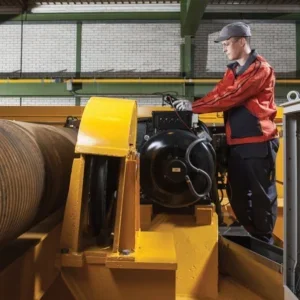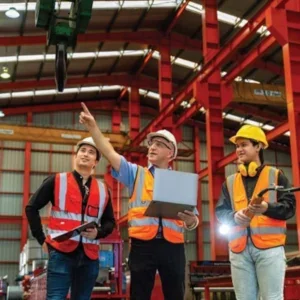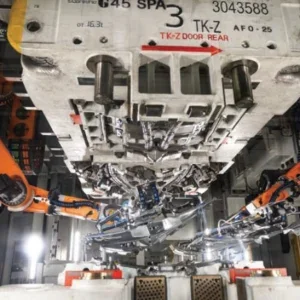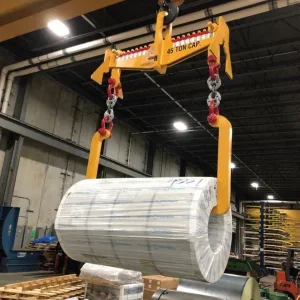As overhead cranes are recognized as integral components of the production process, crane control technology is rapidly evolving. Safety will always be a priority for the hoisting industry, but efficiency and profitability are also driving many of the features overhead crane customer’s request. And control manufacturers are going one step further, marketing systems that are retrofittable for older crane models.
Over the last couple of years, control makers have developed standard versions of the anti-collision, no-fly, and anti-sway functions first introduced as custom safety features for large-capacity crane models. Now, they’re aggressively addressing productivity with standard diagnostics and analytics features. As a result, overhead cranes are becoming an extension of the whole operation.
“The overhead crane was always looked at as a separate operating entity in the facility – a stand-alone machine,” says Dan Beilfuss, vice president of the Crane Manufacturers’ Association of America (CMAA). “Today cranes are linked into the overall plant processes and are sharing data” with each other and the back office.
He says with enterprise resource planning software systems in the office, cranes can produce specific operational data. Warehouse management systems now link crane and facility, as opposed to recognizing and analyzing them separately.
“The crane used to be ‘the machine up in the ceiling,’ says Beilfuss, who also serves as director of sales, Americas, for the crane solutions group of Buffalo, NY-based Columbus McKinnon.
“Today it’s more of an extension of the entire plant processes.”
Beilfuss believes that makes the process more efficient because it allows the crane owner to take advantage of the ability to measure productivity, output, and overall plant efficiency. He can determine how every department and all of its equipment works together.
“It ties back to data analytics: The crane now contributes to the overall plant process through productivity,” he adds.
The demand for simple-to-use safety features has steadily increased over the last decade or so. Several factors are at play, say Beilfuss and Ed Butte, Columbus McKinnon’s global director of product management and strategic marketing.
First, veteran crane operators are retiring. That’s driving the development of features easily integrated and adapted by less-experienced operators, who may have to quickly get a feel for a crane’s capabilities and functionality.
Second, the industry as a whole is safety-conscious. More companies are bringing environmental, health, and safety officers onboard. “In the last few years, as there have become established EHS personnel in plants, the trend reverberates across the industry. Safety is an industry-wide concern,” says Butte.
Company owners are making their facilities safer to work in, while crane manufactures are making machines safer to use. While automation evolves, diagnostics and analytics are “taking the industry by storm,” say Beilfuss and Butte. But having information available at an operator’s fingertips, either by cell or tablet, is a key development.
The crane owner now “can gather information from the crane, measure certain metrics on performance, and get an idea of when a system may break down so he can keep the equipment up and running,” says Beilfuss.
The crane now tells the owner when to replace the ropes, check the bearings, oil, or brakes. Maintenance intervals “can be calculated based on the operation of the crane,” he says.
Last fall, Italian industrial remote-control manufacturer Autec introduced its LIFT series of handheld controllers, which interface with a smartphone app called My Lift Autec. Available for both Android and iOS systems, the remote control has Bluetooth technology.
“Efficiency, ergonomics and ease of use are what operators are looking for,” says Marco Chemello, marketing and communications, Autec.
In addition to a rugged design, the LIFT system displays machine status with four LEDs for data feedback. It allows the operator to monitor the currently selected hoists in a dual-hoist configuration, as well as other machine data.
These types of data collection features on overhead crane controls contribute to warehouse optimization and overall production efficiency.
“Training efforts are significantly reduced thanks to the simplicity to use,” Chemello says, but with the Autec product’s ‘smart’ installation, equipment maintenance activities can be tracked through the smartphone interface.
Safety, uptime, and productivity tools now bring to bear operational matters in systems that network together. Microprocessors in the various systems harness the information that each machine tracks, says Beilfuss.
In 2020, Columbus McKinnon launched Intelli-Connect, its diagnostics package. “We’re trying now to make it the off-the-shelf version of our diagnostics package,” says Beilfuss.
Butte says the coronavirus pandemic actually moved the development forward. “I don’t want to use COVID as an excuse, but it did drive home this ability to monitor machinery and equipment remotely,” he explains.
“People couldn’t get into facilities or travel as readily. We’ve evolved the diagnostic capabilities of overhead cranes more fully in the last couple of years.”
Under the Intelli-Crane banner, Columbus McKinnon developed a suite of products, including a mobile version. Intelli-Connect Mobile takes the information from the machine to the smartphone or tablet. With it, the operator and the back office can now access the information directly from the hoist.
The product is evolving to network multiple systems on a crane and multiple cranes in a facility. The version should be on the market in the next year or so, according to Butte. “This is the device most customers want,” he says.
“With it, you can confirm parameters, check data trends in operations, look back at runs leading up to a fault, and determine what caused the fault. It also helps bring the hoist back online.”
Intelli-Protect is the company’s proprietary no-fly zone function.
As a stand-alone feature, it’s an easy to set up laser positioning system. With it the user can install multiple no-fly zones within a runway, and it includes slowdown functions that restrict the hook movement to, say, only the upper portion when the crane travels over certain zones.
Intelli-Lift is the company’s off-center pick control, ensuring the load is vertically below the hook when the operator lifts it.
Every product in the Columbus McKinnon suite is designed to be field retrofittable. As Butte says; “they’re all designed with the thought that a customer can put them on an existing crane and realize the benefit from better safety and stronger productivity.”
Mazzella Companies, in Cleveland, Ohio, prides itself on offering the crane owner everything under one roof. The company has devoted product research and development efforts in productivity and safety. As a result, its no-fly and collision avoidance systems have been well received by customers.
Recently, Mazzella worked with Laser- View Technologies, Chester Springs, PA, to develop a hoist monitoring system to prevent or mitigate side pulling and snag loading. “Snag load can happen in an automotive facility where you’re swapping out 20- or 30-ton dies, stacked in a die field. The operator knows which die he needs and will pull it from the die field to take to the press,” explains Kenneth Wright, Mazzella’s vice president, process cranes and modernizations.
“If a guy forgets to unhook one side of the die bolster, the die can tip at an angle and can possibly pull. It becomes snagged when the load is hoisted while it’s still connected somewhere.”
Wright believes one of the biggest challenges for the overhead crane industry right now is that younger operators tend to run cranes like a computer console game.
As a result, safety has become “a big deal” in the industry, he says. It’s reassuring that most companies have a high standard for acceptable crane operation. “They don’t just bring somebody in off the street and say ‘read this book.’”
However, operator unfamiliarity with a particular crane’s operation can also be a factor in customers’ seeking simple no-fly and crane monitoring systems, explains Steven Lubeck, Laser-View president. “One of the things that happens in facilities such as automotive plants is people rotate in and out of different departments. An operator may work on a different crane and may not know how the machine will react.”
Similarly, the worker may lack the training required to operate a particular machine and may not realize the crane is unable to stop on a dime, he says.
The company’s Crane Sentry products, chiefly its no-fly zone system, came about at the request of a customer who wanted to keep its cranes with a load from hitting automotive stamping presses. “We take some of the equipment sensitivity out of the mix and make the system more robust. Where we shine is our no-fly zone systems, which have come to life in the past two years along with hoist safety.”
In steel and automotive fabrication plants, no-fly systems keep the crane from hitting buildings, presses and machines, and keep people from lifting a load unsafely. “Imagine picking up a 40-ton die and the load is 12 inches off center as you’re standing next to it,” says Lubeck. “The minute you pick up the load it will swing faster than you can get out of the way. People get smashed or maimed. Our system mitigates side loading or off-center picks.”
If systems that ensure safety are number one on the shopping list, number two is technology that helps achieve higher production levels under the right conditions. Employers “don’t necessarily want crane operators to work quickly, but to operate more precisely – and to prevent damages to staff, equipment, or material being lifted,” says Lubeck.
Wright cites an incident at an automotive plant in Mexico as an example of the need for safety equipment. “They had an incident involving a snag load with a die in the stack. The die fell, and the operator attempting to get out of the way stumbled and fell. As a result of the fall, he broke his arm.”
In the process, the die was also damaged, as was the crane. The company asked Mazzella to determine if there was anything that could be done to mitigate or eliminate the risk in the future.
“We met with their safety and engineering team and presented our idea. We completed a couple of test installs for them in the States, proved it out, and installed several units in the Mexico plant as well as in other plants in the U.S.”
At last count, Mazzella had orders for 20 or 30 more systems yet to be installed.
“The customer’s safety team appreciated the simplicity of the system.” Many controls manufacturers mention their automotive customers first when asked what sectors most often demand the systems.
“Automotive has been a large growth driver for us because stamping plants are handling frequent die changes every hour,” says Lubeck.
“More frequency means less time between die changes and thus they’re more likely to have an incident.”
But the steel industry, and paper and pulp mills are also requesting these types of safety and production products more often. “The automotive sector is an early adopter of this technology,” says Beilfuss of Columbus McKinnon. “Others taking notice are the metal industry – steel or aluminum. Aerospace is utilizing it, and power generation – hydro and nuclear – is taking hold of this safety technology.”
Wright attributes it to the fact that the technology has improved. The market, he says, “is strong right now, and the upswing has been noticeable over the past couple of years.”
Lubeck believes the market is strengthened by the demand for products that improve safety in the workplace.
“We grew 44% last year and this is partly due to the demand for industrial safety systems,” he adds.
In manufacturing plants where multiple cranes often operate in tandem, communication among operators and ground crew is critical. Tele Radio America, Miami, FL, has developed a crane-to-crane communication system as an add-on to the company’s line of remote-control systems.
“Our Tiger LX system will make sure that the corresponding receivers are in constant communication with each other,” says Andreas Bahls, technical sales, Tele Radio Group. The system assures all cranes work in tandem. Should one unit drop out, or reach the end of a runway, it is stopped instantly via a limit switch. The system also functions instantly to slow the crane down.
“A new trend is to equip standard cranes that traditionally used a single receiver to control the hoist/trolley/ bridge motions with two receivers,” he explains. “One receiver controls the hoist/ trolley, the other controls the bridge, eliminating the festoon.
“It may be extended based on customer demands. A crane with two hoists/trolleys would be equipped with three receivers, one for hoist/trolley number one; a second for hoist/trolley number two; and a third for the bridge.”
The company uses proprietary software to provide intelligent settings “for functionality that may otherwise only be achieved using programmable logic controllers or other external devices,” explains Bahls.
The company’s wireless control system removes the operator, who can then control the crane from both a safe distance and an optimal vantage point.
“In addition, remote controls have become very ergonomic, making long hours of operation much easier that being tethered” to a crane, he continues.
And, Tele Radio has made reducing, increasing, or setting safety zones part of the standard operating range integrated into a wireless system.
It’s product lines evolve based on market/customer demand, Bahls says.
One customer recently requested a complicated configuration for its three crane bays. Each bay was outfitted with nine cranes. “The customer requested one transmitter per bay with the ability to select and control any of the nine cranes,” recalls Bahls.
The solution was achieved with nine receivers, one per standard, three-motion, two-speed single-hoist crane in each bay, and one of Tele Radio’s 12-button transmitters. The operator could release the stop switch of the transmitter, at which point the LEDs next to buttons one through nine would light up.
This allowed the operator to select the receiver/crane to be controlled by pressing the corresponding button. He could then press start buttons 11 and 12 to log in to the selected receiver.
The LED next to buttons one through nine corresponding to the selected crane would light up, indicating what crane was selected. Buttons one through six now controlled the hoist/trolley/bridge and button 11, the horn.
“Load control in multiple crane applications is a challenge that can result in lost inventory and more importantly catastrophic accidents at the job site,” says Kevin Hadley, president, American wireless control manufacturer Cervis, Warrendale, PA.
Synchronized tandem crane controls are critical to successful operation of multiple cranes at the same time by the same operator. The system offered by Cervis requires the operator to select the cranes to be used in tandem as well as the communications control, and to confirm radio frequency integrity.
“From a safety standpoint, if one of the cranes should have an RF signal interrupted, its mainline contactor would open and begin a stopping operation,” explains Hadley. “At that time, the second crane being controlled in tandem would also respond to a stop condition.
“This function is completed without the need for secondary systems that may require licensed radio frequencies, he said. “It is an embedded feature of Cervis tandem systems.”
He says customers have shown particular interest, as well, in the Enable feature on Cervis controls. It requires the operator to be hands-on at all times to enable motion control by depressing a guard lever. “It is activated by magnetic vane technology, so there’s no contact switch to wear out,” says Hadley.
The company’s Any Step switch is a handheld control that incorporates two-, three-, and multiple-step push buttons.
The push buttons offer a contactless dual and redundant control for the two-step switch, which monitors two inputs for direct sensing. The three-step switches offer redundant control, and the Any Step package can provide varying speeds digitally or in an analogue format.
“With the release of the Any Step solution, our HHMS model is a one-of-a-kind handheld capable of many variable features combined in one transmitter,” says Randy Butter, vice president of sales for Cervis. “This product will have practically no limitation when it comes to market focus.”






